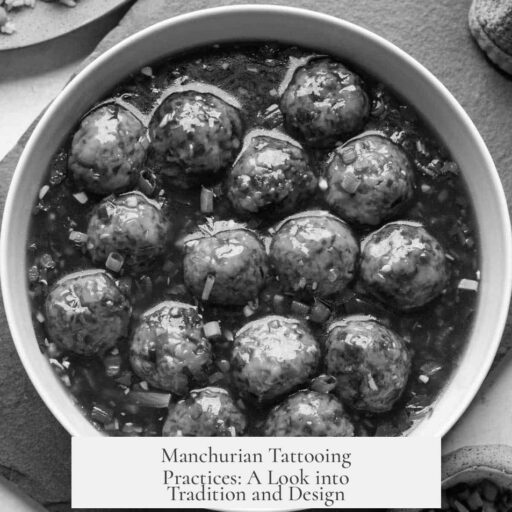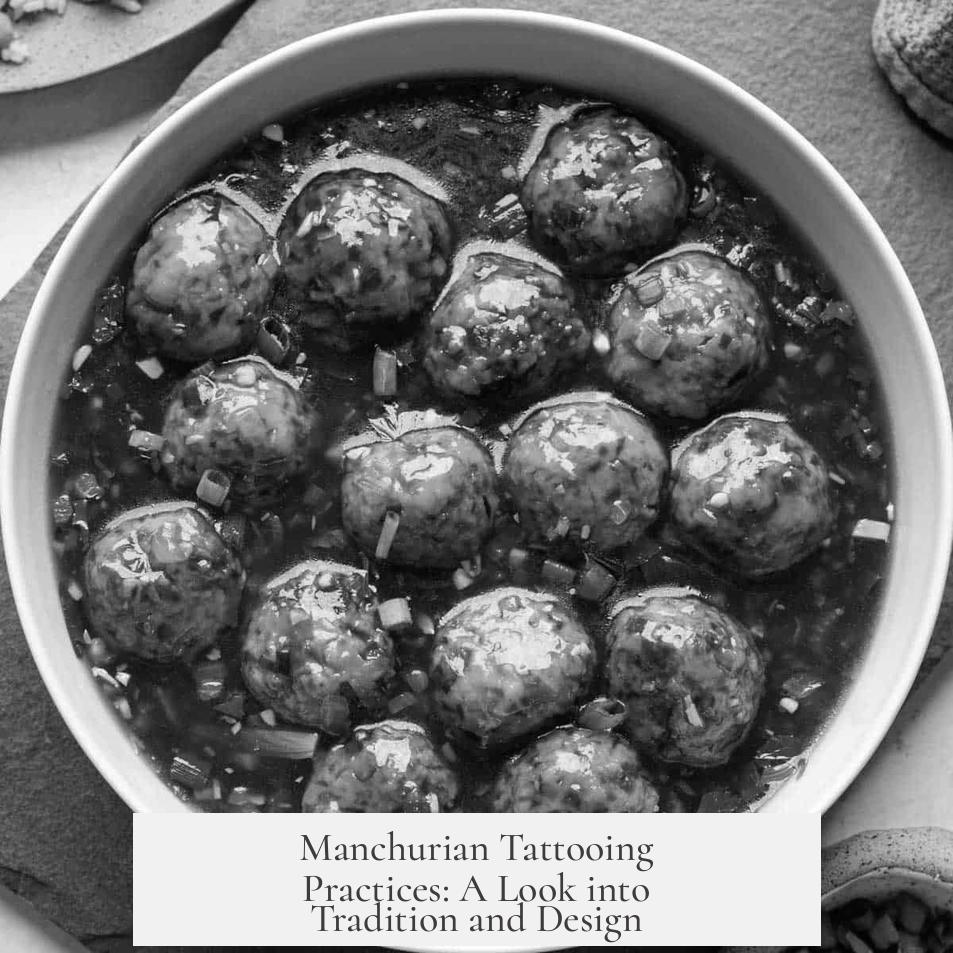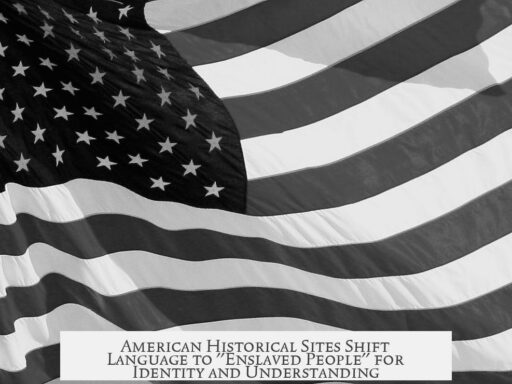The Manchurian people are not documented to have practiced tattooing based on available historical and archaeological data. There is no explicit evidence or detailed records confirming tattoo traditions among them.

While tattooing appears across many cultures near Manchuria, it is absent in direct association with the Manchurian ethnic groups. For example, Siberian cultures bordering Manchuria, such as the Pazyryk culture, show tattooed mummies featuring animal and mythological designs. These tattoos are often intricate and symbolic but relate to peoples distinct from the Manchurians.
In East Asia, tattooing bore varied meanings in neighboring cultures:

- Ancient China regarded tattoos as marks of barbarism or criminality, at times used to brand bandits or prisoners with characters and symbols on visible body parts.
- Japanese tattooing, dating back to the Jōmon period, carried spiritual and decorative significance. The Ainu people, indigenous to northern Japan and parts of the Russian Far East, practiced Sinuye—a tradition involving tattoos around women’s mouths, linked to deities called Kamuy.
These examples show regional tattoo customs with spiritual, punitive, or social coding functions. However, the Manchurian peoples themselves do not feature in this recorded tattooing history. The absence of direct evidence means no reliable descriptions exist of Manchurian tattoo styles, motifs, or their cultural role.
This lack of documentation suggests either tattooing was not a common or preserved practice among the Manchurians, or that future archaeological discoveries may be needed to clarify their customs.

| Aspect | Manchurian Tattooing | Neighboring Cultures Tattooing |
|---|---|---|
| Existence of Evidence | None documented | Well documented (Siberian, Ainu, Chinese, Japanese) |
| Typical Motifs | Unknown | Zoomorphic, mythological, symbolic characters, spiritual marks |
| Cultural Function | Unknown | Spiritual beliefs, social status, criminal marking |
- Manchurian tattoo practices remain unconfirmed and undocumented.
- Neighboring peoples show rich tattoo traditions with varied meanings.
- Tattoo motifs nearby include animals, myths, characters, and ritual markings.
- No visual or textual record describes Manchurian tattoo designs.
- The possibility of Manchurian tattooing requires further research and discovery.
Did the Manchurian People Ever Practice Tattooing? And How Would Those Tattoos Have Looked?
In short, there is no clear evidence that the Manchurian people practiced tattooing, and thus we can only speculate about how such tattoos might have looked. The records and archaeological findings simply do not mention Manchurian tattooing specifically. But don’t lose hope — the world around Manchuria speaks volumes about tattoo traditions, and that can help us imagine what might have been.

Let’s take a closer walk through history and geography, from Siberia to Japan, to unearth clues about tattooing traditions adjacent to Manchuria and what insights they offer.
The Manchurians occupied a region that overlaps parts of northeastern China, Russia’s Far East, and neighboring lands. This places them near cultures with notable tattooing histories, especially Siberian tribes like the Pazyryk culture, and the Ainu of Japan. Since tattooing is often a deeply regional and cultural practice, neighboring customs can offer hints.

Tattooing Around Manchuria: A Neighbourly Tradition
Across Siberia, people have been tattooing skin since ancient times. Archaeologists found tattooed mummies from at least 49 sites scattered between Siberia, Mongolia, western China, and even Japan. The famous Pazyryk culture of southern Siberia is perhaps the best-known. Those mummies flaunted tattoos featuring intricate zoomorphic and mythological images etched into their skin. Can you imagine the artistry—bear heads, deer antlers, and perhaps mythical beasts curling across frozen flesh? Sadly, we don’t have exact visuals here, only tantalizing references that inspire awe.

Moving down to East Asia, the ancient Chinese had an ambivalent relationship with tattoos. They often saw tattooing as “barbaric,” linking it with the Yue people of southern China. To the Chinese, tattoos could label someone as a bandit or criminal, with marks like 囚 (“prisoner”), crosses, circles, or lines tattooed on faces and arms. Tattoos could also be badges of loyalty or infamy—legend tells of a Song dynasty general who bore the words “Repay the Country with Pure Loyalty” as a tattoo.
Meanwhile, Japan offers a distinct perspective. Tattooing there dates as far back as the Paleolithic or Jōmon period, serving spiritual and decorative roles. The Ainu people of northern Japan, culturally related though distinct from the Manchurians, practiced a unique tattooing style called Sinuye. Ainu women received mouth tattoos that connected them to their gods, the Kamuy. These tattoos were not just decoration but a spiritual rite. Imagine delicate patterns around the mouth — a visible oath to the divine.

What About the Manchurians Themselves?
Given this rich patchwork of tattoo culture nearby, the glaring absence of mention regarding Manchurian tattooing is puzzling. Are we facing a gap in historical records, or did the Manchurian people simply avoid this practice?
No archaeological finds or texts confirm that the Manchurian people tattooed themselves. This may be due to lost records, oral traditions not recorded by outsiders, or genuinely different cultural norms. Manchuria’s climate and burial customs may have further obscured any tattoo evidence. Sometimes what survives in the physical record is just a fraction of what once existed.
In terms of appearance, if Manchurian tattoos did exist, they might have resembled tattoos from neighboring groups. Possibly the tattoos involved:
- Animal motifs: Like the Pazyryk, animals featuring prominently in local myths, such as tigers, wolves, or birds, could be tattooed on the body.
- Symbols and patterns: Possibly abstract designs or symbols denoting social status, achievements, or clan affiliation.
- Spiritual elements: Patterns invoking protective spirits or deities, considering the spiritual significance seen in Ainu tattoos.
- Functional markings: Maybe tattoos served as markers in rituals, for healing, or even as punitive badges (as in Chinese criminal tattoos).
Why Does This Matter Today?
Exploring ancient tattooing isn’t just trivia—understanding body art traditions reveals a people’s values, social structures, and spiritual beliefs. The absence of clear Manchurian tattoo evidence spotlights the gaps in our historical knowledge. It nudges us to appreciate the limits of existing research and encourages new investigations into this fascinating region’s culture.
For tattoo enthusiasts and historians alike, the mystery is both frustrating and thrilling. Imagine discovering a Pazyryk-like tattoo on a Manchurian mummy someday! Such a discovery would reshape our understanding of Northeast Asian cultural dynamics.
Final Thoughts — An Invitation to Imagine and Explore
“What if the Manchurian people had tattoos? What stories would those inked lines tell?”
Despite the lack of direct evidence, neighboring cultures clad their skin in art, stories, and social signals. The Pazyryk’s mythic beasts, Chinese social branding, and Ainu spiritual markings show tattooing’s broad spectrum in regions touching Manchuria.
So, can we say the Manchurians practiced tattooing? Not for sure. But their proximity to tattooed neighbors makes it unlikely the practice was totally unknown. If Manchurians tattooed, their designs might have mixed animal motifs, spiritual symbols, and social markers—melding Siberian boldness with East Asian meaning.
Next time you see a fierce, intricate tattoo, think about these hidden cultures and their lost skin stories. And maybe consider this as inspiration for your next ink—a nod to the silent, invisible traditions of Manchuria.
Did the Manchurian people practice tattooing?
The content does not mention that the Manchurian people practiced tattooing. No direct evidence or records were found about tattoos among them.
What kind of tattoo designs did neighboring Siberian cultures have?
Siberian groups like the Pazyryk had tattoos with animal and mythological images. These designs often reflected spiritual or cultural meanings.
How were tattoos viewed in ancient China near Manchuria?
Tattoos were seen as barbaric. They marked criminals or bandits with symbols like crosses, lines, or Chinese characters, often on visible body parts.
Did the Ainu people, neighbors to Manchuria, have distinct tattoo practices?
Yes, Ainu women had mouth tattoos called Sinuye linked to their deities, the Kamuy. These tattoos held spiritual significance.
Is there any description of how Manchurian tattoos would have looked?
No descriptions exist. Since no tattooing is recorded among Manchurians, we cannot say how their tattoos might have appeared.




